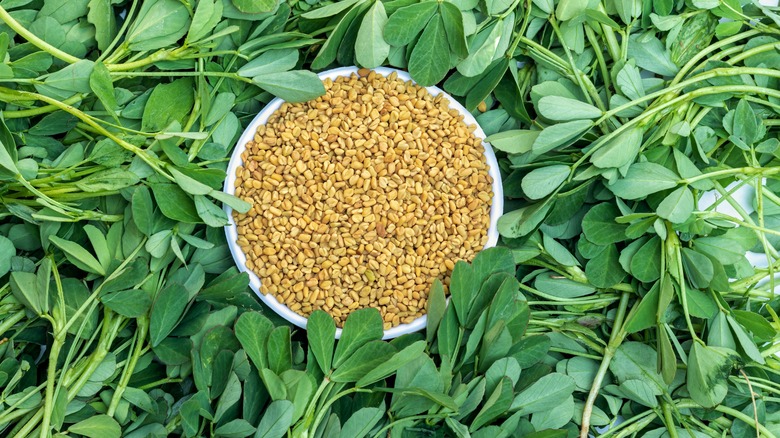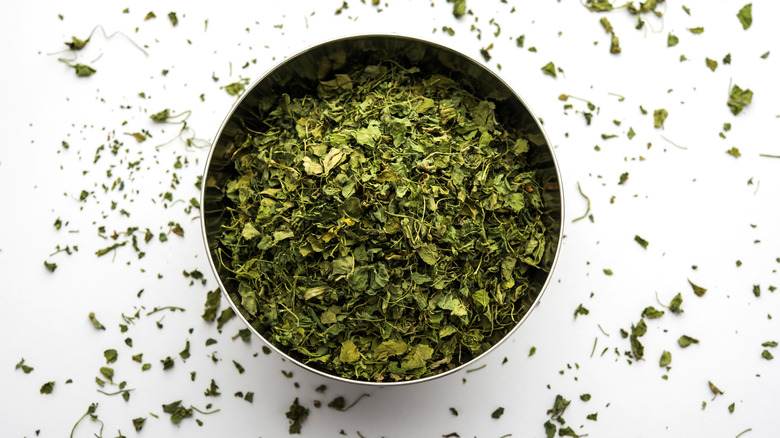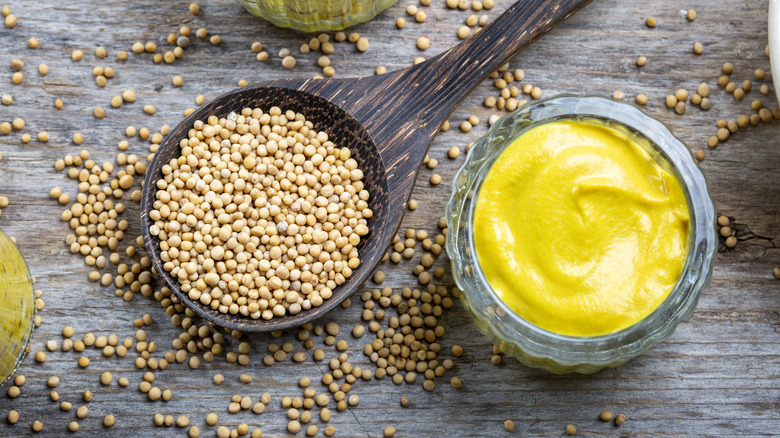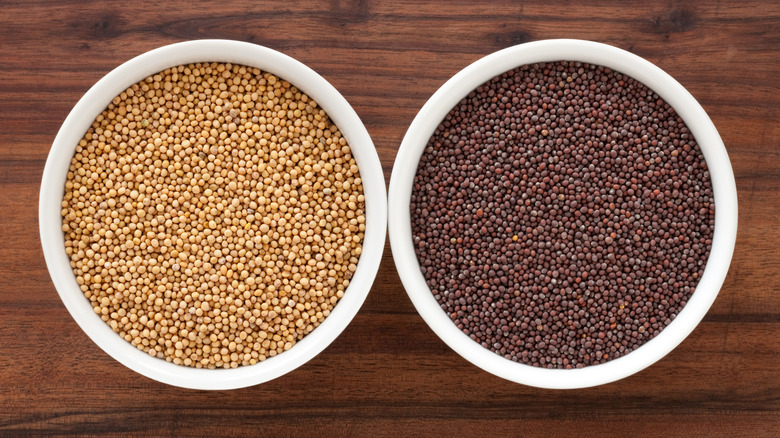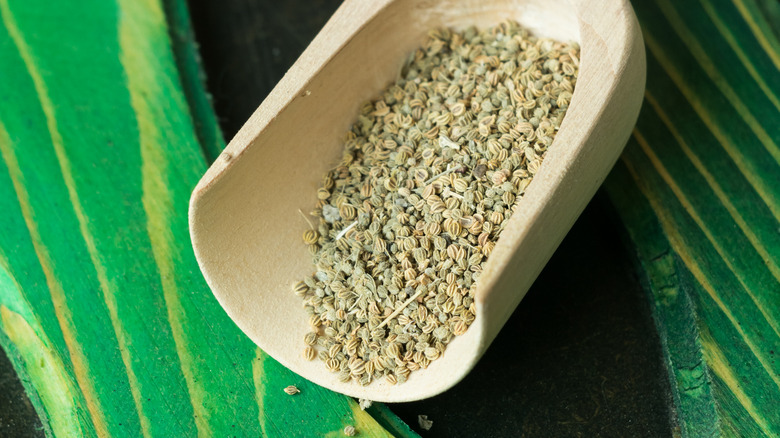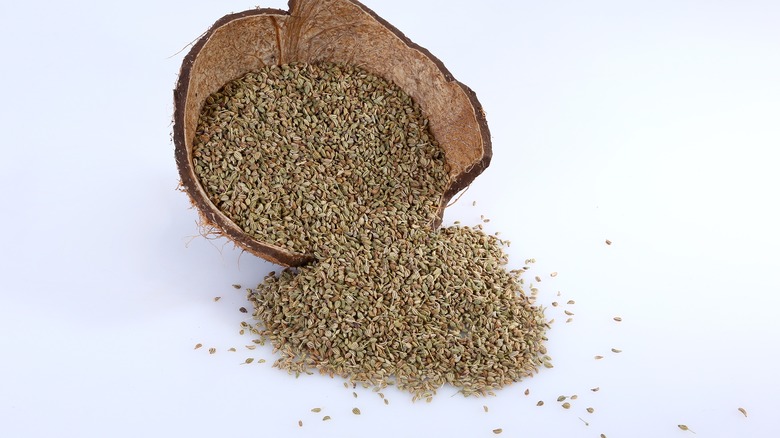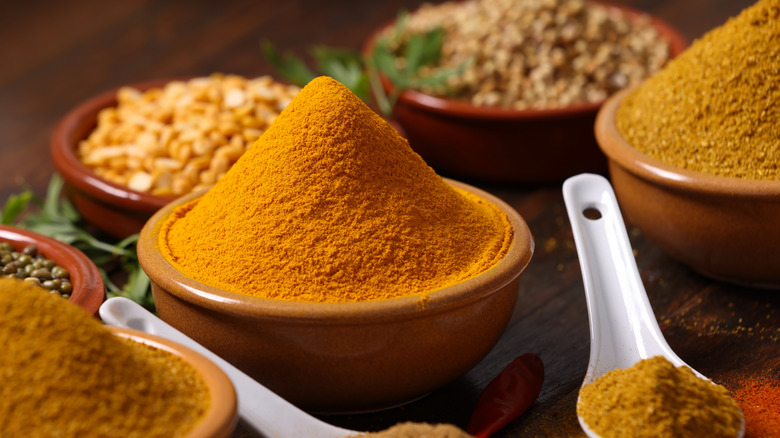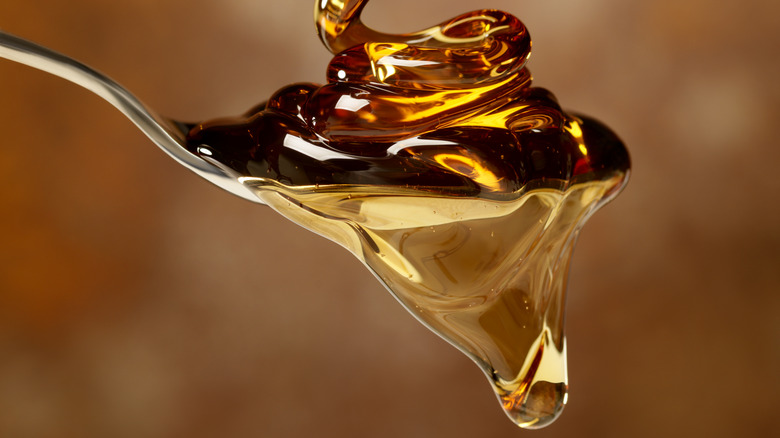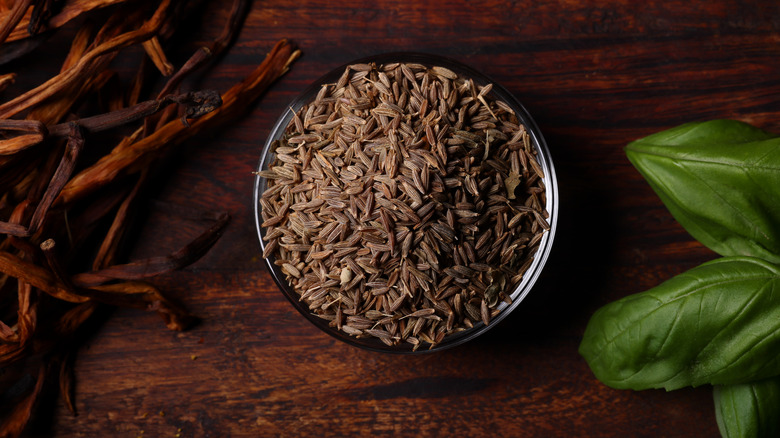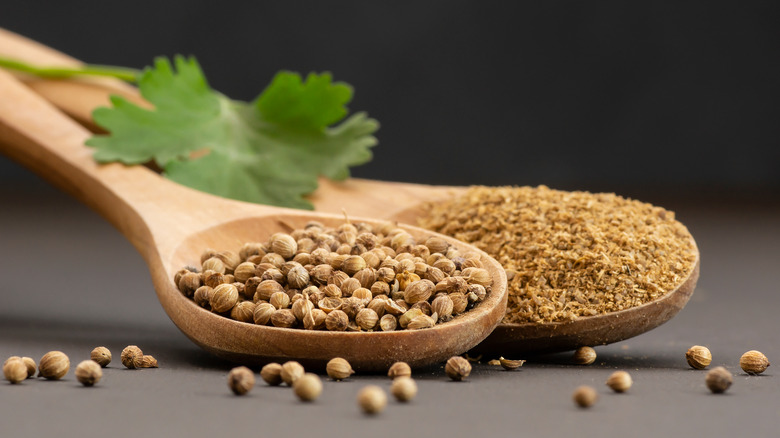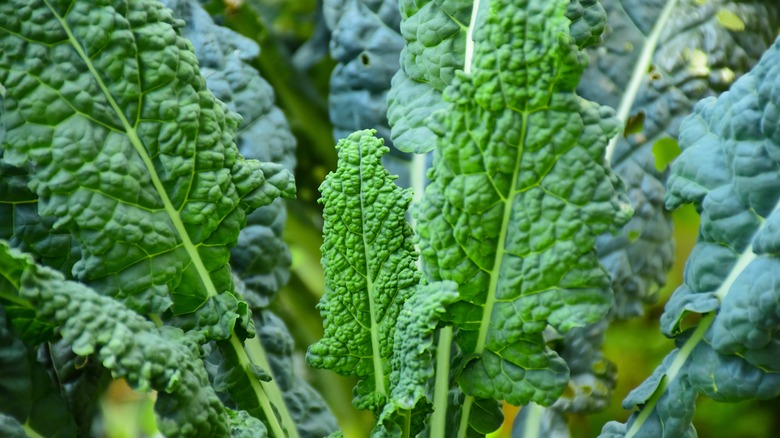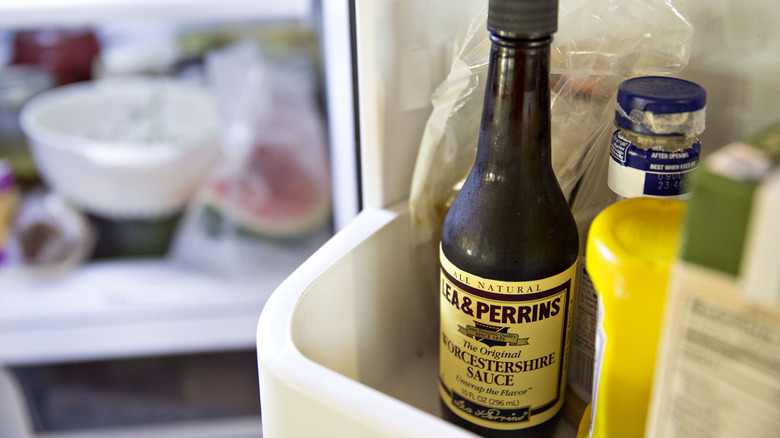11 Best Substitutes For Fenugreek
Fenugreek (Trigonella foenum-graecum) is an herb found in a variety of recipes, including Indian curry and Ethiopian berbere spice rub, as well as teas, spice blends, sprouted salads, and more. The plant stands around 2 to 3 feet tall with dainty white flowers, trios of green leaves, and tiny golden seeds. The leaves and seeds are edible, but the flavor varies depending on whether they're consumed fresh, dried, lightly fried, or crushed. Raw fenugreek, for example, imparts nutty, bitter, and slightly sweet notes. Dried fenugreek leaves (kasuri methi) are the most bitter form, so they're often used for soups and curries. The seeds can also be soaked to reduce bitterness or toasted to add sweetness and flavor.
You may know what fenugreek is and how to use it, but what happens when you run out of it? Although its multidimensional taste and aroma make it difficult to find a substitute, there are ways to use other herbs and spices that offer a similar complexity and flavor boost to your meal. These simple swaps can also be beneficial for folks who can't eat fenugreek, as it has been suggested that the herb can lower blood sugar, so it may be unsuitable for people with diabetes, pregnant and breastfeeding individuals, or those taking heart medications.
How to choose the best substitute
While fenugreek is championed in cuisines around the world, determining the best substitute for any given dish may require that you color outside the lines of culture. Often, it's a matter of examining the texture and the role fenugreek plays in the original recipe. A curry that calls for crushed dried fenugreek, for example, is likely relying on the spice's complex flavor to blend and enhance the other ingredients. It makes sense to, therefore, substitute dried fenugreek leaves with other dried leaves because they perform the same function. Similarly, substituting fenugreek seeds with maple syrup in dukkah, a Middle Eastern condiment, isn't a great fit because the texture will be different, as maple syrup is far too wet to work in a dry spice blend.
Your best strategy is to first identify the reason fenugreek is used in a dish, such as for aroma, texture, or flavor, and then match it with another functional ingredient. You should also consider the cuisine at play, as you may find inspiration for similar groups of flavors and ingredients.
Fennel seeds and yellow mustard seeds
There might not be one magic, catch-all substitute for fenugreek. But a close one is a mixture of fennel and mustard seeds, which can substituted for fenugreek seeds using a 1-to-1 ratio. Here, the fennel seeds — tempered by the mustard seeds — speak to fenugreek's signature hint of sweetness. Meanwhile, the mustard seeds offer bitterness to ground the flavor profile. It should be noted that the mustard seeds have a rather pungent flavor. You can lightly crush and toast both the mustard and fennel seeds to moderate it.
If you're out of yellow mustard seeds, use mustard powder or honey-dijon mustard with the same ratio. However, you're potentially working with a wet replacement for a dry ingredient, which is not an ideal textural match.
Alternatively, you could try turmeric as a mustard substitute for more aromatic dishes like curries and burgers. Turmeric is less spicy and more bitter than mustard, which may bring it closer to fenugreek's flavor profile. The only issue is that without the mustard seeds, the fennel's sweetness will likely overpower the turmeric's flavor. Plus, that quintessential turmeric smell will infuse your dish, which might make sense in Indian recipes but not others.
Black or brown mustard seeds
Black and brown mustard seeds are also great fenugreek substitutes. These variants have distinct flavor profiles; black mustard seeds have a punchier taste, while brown mustard seeds are less potent and more accessible. The moderate taste makes brown mustard seeds a better substitute for fenugreek, but you can also use a mixture of black and yellow seeds to moderate the taste.
South Indian okra samba is one recipe where either brown or black mustard seeds can be used as a fenugreek substitute. Both the spice blend and vegetable mix call for fenugreek seeds combined with other aromatics like black mustard seeds, turmeric, and cinnamon. The best substitute for fenugreek in this recipe would be more black mustard seeds or brown mustard seeds, as either addition would blend into and amplify the other ingredients in the dish. As with any substitution, always taste as you go and add more spice as needed.
Celery seeds
Another great substitute for fenugreek seeds is celery seeds, which can be swapped using a 1-to-1 ratio. Celery seeds come from wild celery, which grows readily in the Mediterranean. Although you can purchase celery salt and flakes, too, seeds are always the best option to substitute for fenugreek seeds. As one would imagine, the seed's taste is reminiscent of a fully-fledged vegetable, which could be an issue if celery isn't the flavor you're going for. Celery seeds are considered bolder and spicier than fenugreek due to an unrivaled level of bitterness, which may shift the balance of the entire dish.
One recipe where celery seeds could be a great substitute for fenugreek is in a fig-saba jam. It features some of the same Mediterranean ingredients that are often paired with celery seeds like grape must syrup and citrus. Fenugreek's role, along with black pepper, is to help balance the sweeter elements in a grounding, savory way. To ensure the flavor doesn't lean bitter, it's best to add a small amount of celery seeds, taste them, and go from there.
Carom seeds
Carom seed, from the ajwain herb, is one of the essential ingredients for Indian cooking, although it's less known outside of the region. Despite the name, these seeds are not exactly seeds; rather, they're the fruit of the ajwain herb.
The tiny fruit resembles cumin and caraway seeds in shape and texture, and its flavor has been likened to thyme and oregano. Raw carom has such a strong taste it almost stings the palate. But heating it slightly mellows out the bitterness, so if you are in doubt, pre-toast it to take the edge off. Carom may work well as a substitute for fenugreek in recipes that call for raw seeds, such as in an Ethiopian spiced butter called niter kibbeh, because, like carom, raw fenugreek has bitter notes. Carom might also be a good option in recipes that call for a spice blend with citrus, sweet, or floral elements to counter the bitterness.
Curry powder
This is a bit of a cheeky substitute, as many common curry powders, like Indian garam masala and panch phoran, typically contain fenugreek. If you use these spices, you can be sure that there will be fenugreek in your dish, but the quantity will be small. You can determine the most suitable curry powder to use as a fenugreek substitute by considering the other ingredients in the dish.
Garam masala and panch phoran, for example, work well in Indian dishes and chutneys, whereas berbere is best substituted in dishes like our Moroccan-spiced carrots. Here, it's more about amplifying the overall experience of this dish and working with complementary regional flavors. Japanese curry powder often contains fenugreek, too, along with turmeric and mushroom powder. To amplify the flavors of this regional curry powder, consider using it for umami-rich seafood, mushrooms, and soy-based dishes, where the flavors can really shine.
Maple syrup
Maple syrup might not actually be the perfect fenugreek substitute it's been made out to be. It often makes the top list of fenugreek substitutes because of sotolone, a chemical compound behind the maple-like smell in fenugreek. So, science says the substitution is logical, at least in terms of smell. But it's the delicate, yet punchy, bitterness of fenugreek that maple syrup just can't replicate. In reality, the syrupy product may only be able to replicate the flavor of dried fenugreek — and only to match its aroma. For example, that's needed when replacing fenugreek in kuku sabzi, a Persian herb omelet.
The other potential, and perhaps better, application of maple syrup is in combination with other substitutes like ground yellow mustard seeds and celery seeds. Combined, they form the ultimate substitute, checking off the earthy, herbal, and sweet scent boxes. If you're making a soup or sauce and you're set on substituting fenugreek with maple syrup, add the syrup gradually, as too much will make your dish overly sweet.
Cumin seeds
Another substitute for fenugreek is cumin seeds, which are part of the fruiting body of the plant. Like fenugreek, the taste of cumin is complex, with a blend of warming flavors and aroma — earthy, nutty, and savory with a touch of sweetness — which makes it one of the best fenugreek substitutes. It's also one of the most essential spices to have in your pantry as it appears in Indian, Eastern, Middle Eastern, Mexican, and Portuguese cuisines (and more). You can swap fenugreek seeds for cumin seeds (or ground fenugreek for cumin powder) with a 1-to-1 ratio.
One recipe where cumin can easily act as a fenugreek substitute is amba – a Middle Eastern condiment made with pickled mango. While the exact ingredients vary from region to region, it's typically made with cumin, coriander, cloves, fenugreek, mustard seeds, ginger, and red chilis. Note that this lineup is essentially fenugreek — plus common fenugreek substitutes — so the best substitute here would be to increase the quantities of cumin and other spices.
Cilantro and ground mustard
Mustard isn't surprising here, given that one of the best substitutes for fenugreek is a mixture of mustard and fennel seeds. But that's not the only combination, as mustard can also be matched with cilantro powder or seeds. In both combinations, the mustard brings a peppery, spiced potency that contrasts the lighter, sweeter, and more herbaceous characteristics of the cilantro. It's the citrus element that sets cilantro apart, so the resulting dish may taste brighter than the original recipe made with fenugreek.
This could actually work in your favor in recipes like butter chicken, where fenugreek is used for its sweetness. The cilantro can cut through the sauce's creaminess and complement the tomatoes' acidity, which is tremendously helpful in balancing the notoriously heavy dish. A hint of citrus would add a refreshing zing that could be perceived as sweetness and provide an overall reprieve from the intense flavors and hearty consistency.
Leafy greens
When fenugreek features in a recipe in fresh leaf form, you might be tempted to substitute on color alone. But mustard greens, kale, spinach, and celery also offer a flavor that will change your dish entirely.
Finely chopped mustard greens can be used as a 1-to-1 substitute to bring out a dish's pepperiness. However, this swap will contribute nothing sweet. Kale is another great option for imbuing bitter edges to a recipe, but also lacks sweetness. Meanwhile, celery leaves, especially those from Chinese celery, will give a kick to a dish that's perhaps just slightly weaker than that of fenugreek. Here's where a small addition of maple syrup can be an inspired move; if you're whipping up a salad or a stir-fry, go for a dressing with a touch of sweetness to cut through that bitterness. Or, in the case of an Indian biryani that calls for fenugreek leaves, you could substitute your choice of greens and add some chopped dried fruit for sweetness.
Curry leaves
Another great fenugreek substitute, particularly when the recipe calls for dried fenugreek leaves, is curry leaves. But before we venture further, let's set the record straight: curry leaves have nothing to do with curry powder.
Unlike the seemingly endless variations of curry dishes you'll encounter across the world, there's only one type of curry leaf (Murraya koenigii). Curry leaves have almond-shaped leaflets branching off a main stem and a unique scent created by over 20 naturally occurring compounds. Mostly, the smell is summarized as citrus or something similar to lemongrass or anise. Although, as usual with spices, the reality is that the flavor is much more complex than that.
The most compelling argument for using curry leaves in place of dried fenugreek is purely textural rather than taste-related. It's easy to incorporate them into meals where fenugreek leaves are commonly used, too, like curries and dukkah. If you want an even better flavor, lightly fry your curry leaves in oil until crispy before adding them to your dish.
Worcestershire sauce
Worcestershire sauce is a complete curveball of a fenugreek substitute, but that bottle lurking away in some near-forgotten spot in your kitchen might turn out to be an unsung hero. Fenugreek is a statement ingredient; it's unapologetically vivid on the palate. Worcestershire sauce, which can also be used as an ingredient swap for mustard, harnesses a tangy, sweet, and acidic blend of vinegar, molasses, anchovies, salt, sugar, and spices that mimics the same complexity as fenugreek.
Substituting Worcestershire sauce for fenugreek will undoubtedly alter the flavors, and it won't work for every dish. But if the recipe is all about culinary drama, Worcestershire sauce, perhaps combined with crushed fennel or coriander seeds, is worth considering as a fenugreek substitute. When combined with one of these grounding spices, Worcestershire sauce could prove an excellent, albeit unexpected, substitute for fenugreek in meats, marinades, or sauces. Start with a splash of sauce, taste test, and then add more to taste.
